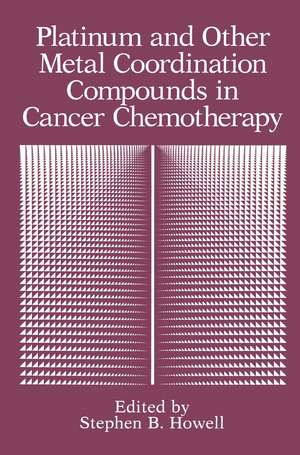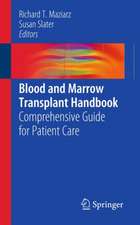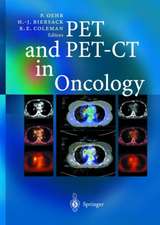Platinum and Other Metal Coordination Compounds in Cancer Chemotherapy
Editat de Stephen B. Howellen Limba Engleză Paperback – 18 iun 2013
| Toate formatele și edițiile | Preț | Express |
|---|---|---|
| Paperback (1) | 2118.14 lei 6-8 săpt. | |
| Springer Us – 18 iun 2013 | 2118.14 lei 6-8 săpt. | |
| Hardback (1) | 2125.64 lei 6-8 săpt. | |
| Springer Us – 28 feb 1992 | 2125.64 lei 6-8 săpt. |
Preț: 2118.14 lei
Preț vechi: 2229.62 lei
-5% Nou
Puncte Express: 3177
Preț estimativ în valută:
405.36€ • 421.64$ • 334.65£
405.36€ • 421.64$ • 334.65£
Carte tipărită la comandă
Livrare economică 14-28 aprilie
Preluare comenzi: 021 569.72.76
Specificații
ISBN-13: 9781489907400
ISBN-10: 1489907408
Pagini: 560
Ilustrații: XII, 546 p.
Dimensiuni: 155 x 235 x 29 mm
Greutate: 0.78 kg
Ediția:Softcover reprint of the original 1st ed. 1991
Editura: Springer Us
Colecția Springer
Locul publicării:New York, NY, United States
ISBN-10: 1489907408
Pagini: 560
Ilustrații: XII, 546 p.
Dimensiuni: 155 x 235 x 29 mm
Greutate: 0.78 kg
Ediția:Softcover reprint of the original 1st ed. 1991
Editura: Springer Us
Colecția Springer
Locul publicării:New York, NY, United States
Public țintă
ResearchDescriere
Taken together the data presented in this review, and work by many other investigators, support the notion that DNA excision repair is important in a tumor cell's resistance to platinum compounds. Inhibition of this repair system by combination chemotherapy with the excision repair inhibitors HU and Ara-C produces synergistic cell kills and increased levels and persistance of DNA interstrand crosslinks. The studies with cis-DDP and ~-DDP in combination with UV induced thymine dimers suggest that there may be competition for DNA repair enzymes between the dimer and the platinum lesion. Whether the competing lesion is an intrastrand crosslink, interstrand crosslink, or platinum monoadduct (or all of these lesions) cannot be determined. The similarity between an intrastrand crosslink and a cyclobutane dimer suggests that these lesions may compete for repair. However, the increased peak levels of interstrand crosslinks, and increased persistence of these lesions at later time points suggest that this lesion may also be a substrate for the repair system. These observations may be of clinical relevance. Recently Dr. Kathy Albain of our institution has completed a Phase III I study using a 12 hour pretreatment with HU and Ara-C in patients prior to their cis-DDP therapy. She observed a significant number of responders in this trial (54). She is currently completing a second Phase IIII study substituting IV HU for the oral formulation. We anticipate initiating other clinical trials based upon these observations.
Cuprins
Synthetic Chemistry and Biochemistry: Platinum DNA Chemistry; S. Lippard. New Insights about the Interaction of Cisplatinum with Intracellular Components; J. Reedijk. Modelling Platinum-DNA Interactions; B. Lippert. From the Modelization of DNA Platination to the Conception of New Drugs; J.C. Chottard. Biochemical and Molecular Pharmacology: Role of Membrane Ion Transport in Cisplatin Accumulation; P.A. Andrews. Enhancement of the Antiproliferative Effect of Cisdiamminedichloroplatinum (II) and Other Antitumor Agents by Inhibitors of Enzymes Involved in Growth Factor SignalTransduction; H.H. Grunicke. Signal Transduction Pathway Regulation of DDP Sensitivity; S.B. Howell. The Role of Platinum-DNA Lesions in the Inhibition of DNA Replication; N.P. Johnson. Toxicology and Clinical Pharmacology of New Drugs: Pharmacokietics of Carboplatin in Children and the Development of a Pediatric Dose Equation; H. Calvert. Clinical Studies with Cisplatin Analogues, 254S, DWA2114R and NK121; H. Majima. Clinical Trials: Dose Intensity Analysis May Help Resolve Issues in Chemotherapy with Platinum Compounds; W. Hryniuk. Cisplatin DoseIntensity in Testicular Cancer Treatment: Analysis of a Randomized Clinical Trial; C.R. Nichols, et al. 39 additional articles. Index.











